Procore Bundle
Can Procore Revolutionize Construction Management?
Procore Technologies, Inc. stands at the forefront of construction technology, transforming how projects are managed globally. With a market capitalization of $10 billion and a robust revenue stream, Procore is not just participating in the digital transformation; it's leading it. This analysis delves into the Procore SWOT Analysis, exploring its strategic initiatives and future trajectory.
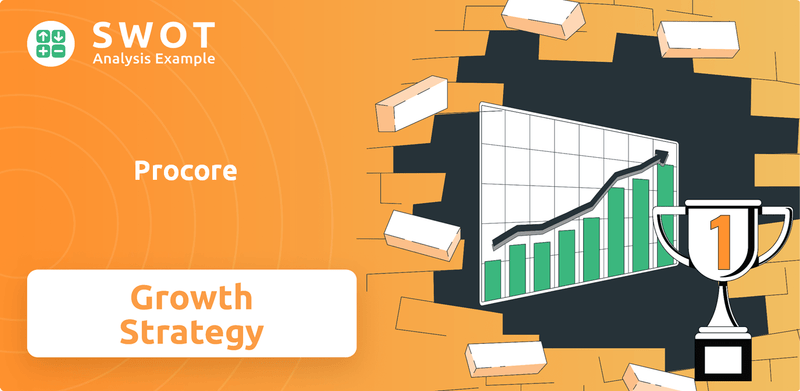
This comprehensive Procore company analysis will dissect Procore's growth strategy, examining its expansion plans and innovative approach to construction management software. We'll explore Procore's future prospects in a rapidly evolving market, analyzing its financial performance and competitive landscape within the construction technology trends. Understanding Procore's adoption rate, strategic partnerships, and investment in innovation is crucial for investors and industry professionals alike.
How Is Procore Expanding Its Reach?
The Procore growth strategy centers on aggressive expansion initiatives designed to broaden its market reach and enhance its product offerings. This approach is crucial for maintaining its position in the competitive construction technology landscape. By focusing on both international expansion and strategic acquisitions, Procore aims to capture a larger share of the global construction management software market.
Procore future prospects look promising, driven by its commitment to innovation and its ability to adapt to evolving industry needs. The company's strategic moves, including the development of new features and the integration of advanced technologies, are expected to fuel sustained growth. This proactive stance positions Procore favorably to capitalize on the increasing adoption of construction technology trends.
A comprehensive Procore company analysis reveals a company dedicated to long-term growth. Its investments in international markets and product development are key indicators of its strategic vision. Procore's ability to integrate new technologies and adapt to market demands will be critical to its continued success and its ability to maintain and grow its Procore market share.
Procore is actively expanding its global footprint to tap into new markets. Offices have been established in major hubs like Sydney, Toronto, London, Dublin, and Dubai. This allows Procore to tailor its services to regional requirements.
Procore continuously enhances its platform through organic development and strategic acquisitions. Recent acquisitions like Novorender AS (January 2025) and Intelliwave Technologies Inc. (May 2024) broaden its capabilities. These moves aim to attract a wider range of stakeholders.
Procore acquired Unearth Technologies Inc. in September 2023, enhancing its geographic information systems asset management. The acquisition of Procore Pay in September 2023 streamlines payment processes for contractors and subcontractors. These moves are designed to improve the user experience and expand the platform's functionality.
Procore is transitioning to a general manager model to localize its approach and enhance service to regional markets. This strategic realignment aims to improve customer relationships and drive efficient long-term growth. The shift is expected to be fully operational by the second half of 2025.
Procore's expansion strategy includes both geographic and product-focused initiatives. The company is investing heavily in international markets while also expanding its suite of services. These initiatives are designed to increase Procore's revenue growth and solidify its position in the construction management software market.
- International Expansion: Establishing offices in key global locations to serve diverse construction projects.
- Strategic Acquisitions: Acquiring companies like Novorender AS and Intelliwave Technologies Inc. to enhance its platform.
- Product Development: Launching new solutions like Procore Pay to streamline processes.
- Go-to-Market Strategy: Implementing a general manager model to improve customer service and drive growth.
Procore SWOT Analysis
- Complete SWOT Breakdown
- Fully Customizable
- Editable in Excel & Word
- Professional Formatting
- Investor-Ready Format
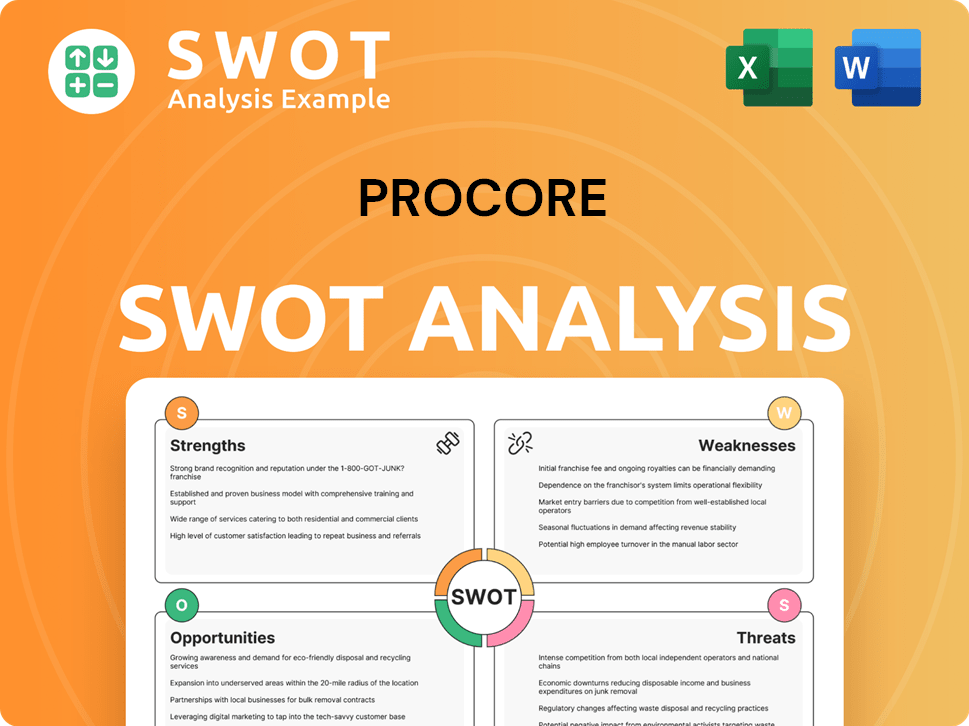
How Does Procore Invest in Innovation?
The core of the Procore growth strategy is centered on technology and innovation. The company consistently invests in research and development to enhance its platform. This focus allows it to meet the evolving needs of the construction industry and maintain a competitive edge. Procore's commitment is evident in its product development roadmap and its proactive approach to construction technology trends.
Procore's future prospects are closely tied to its ability to integrate advanced technologies. Digital transformation, automation, and the application of Artificial Intelligence (AI) and the Internet of Things (IoT) are key areas of focus. These advancements aim to streamline operations, improve efficiency, and provide better insights for construction projects. This strategy is designed to address key challenges and capitalize on opportunities within the construction industry.
Procore's company analysis reveals a strong emphasis on innovation. This is reflected in its strategic initiatives and the development of new features. The company aims to provide comprehensive solutions for construction management, which should drive its adoption rate in the industry.
At Groundbreak 2024, Procore launched Procore AI. This includes new AI-powered Agents designed to boost project efficiency. These agents are intended to improve decision-making processes within construction projects.
The integration of AI across various tasks and workflows is a key focus. This aims to automate repetitive tasks and streamline workflows. The goal is to reduce inefficiencies and improve overall project management.
Procore's AI integration aims to reduce significant inefficiencies. For example, it addresses the issue of time lost searching for data, which currently accounts for 18% of project time. It also tackles rework, which wastes 28% of project time.
Procore's vision for 2025 centers on driving innovation with AI and data. It also focuses on empowering workforce development. Automation is integrated with augmentation to minimize risk and improve productivity.
Recent acquisitions like Novorender and FlyPaper Technologies enhance BIM capabilities. These acquisitions aim to streamline data management and improve design coordination. These efforts contribute to Procore's product development roadmap.
Procore's platform automates measurements. It provides immediate cost estimates, which frees up contractors' time. This allows them to focus on risk analysis and other critical tasks.
Procore's commitment to innovation is evident in its strategic initiatives and product offerings. The company's focus on AI, automation, and data-driven insights positions it well for future growth. This approach is designed to address the challenges and opportunities within the construction sector, influencing Procore's market share.
- Procore AI Agents aim to improve project efficiency and decision-making.
- AI integration is designed to automate tasks and streamline workflows.
- Recent acquisitions enhance BIM capabilities and data management.
- The platform offers automated measurements and cost estimates.
- Recognition on Fortune Magazine's Future 50 list highlights its long-term growth potential.
For a deeper understanding of the competitive landscape, consider reading about the Competitors Landscape of Procore. This will provide insights into how Procore's innovation strategy compares to its competitors.
Procore PESTLE Analysis
- Covers All 6 PESTLE Categories
- No Research Needed – Save Hours of Work
- Built by Experts, Trusted by Consultants
- Instant Download, Ready to Use
- 100% Editable, Fully Customizable
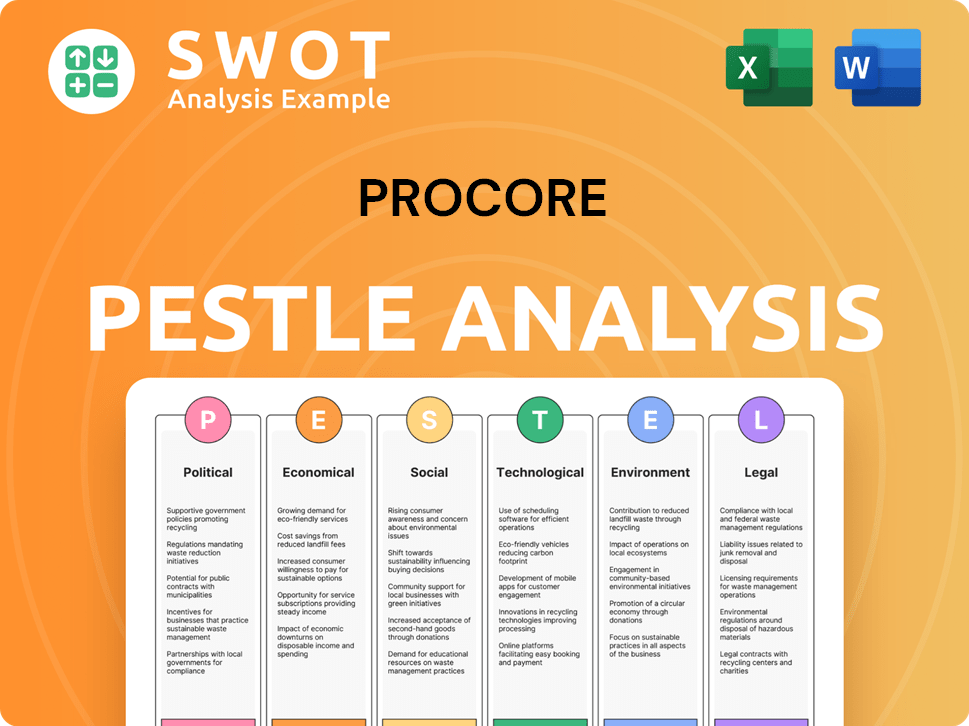
What Is Procore’s Growth Forecast?
The financial outlook for Procore Technologies reveals a robust trajectory, underpinned by solid revenue growth and strategic financial management. The company's performance in 2024 and its projections for 2025 highlight its strong position in the construction management software market. This analysis provides a detailed look at Procore's financial health, including revenue, margins, and cash flow, offering insights into its growth strategy and future prospects.
Procore's financial strategy emphasizes sustainable growth and profitability. The company's focus on margin expansion and efficient capital allocation is evident in its financial results and future guidance. These initiatives are designed to enhance shareholder value and support long-term growth in the construction technology trends.
Procore's commitment to innovation and strategic partnerships further strengthens its market position. The company's investments in product development and expansion plans are key drivers of its future success. For a deeper understanding of the company's origins, you can explore the Brief History of Procore.
Procore's revenue reached $1.152 billion in 2024, marking a 21% year-over-year increase. This strong performance reflects the company's ability to capture market share and drive adoption in the construction management software industry. This growth is a key indicator of Procore's financial performance.
The non-GAAP operating margin for 2024 was 10%. This demonstrates Procore's focus on operational efficiency and cost management. The margin is a critical factor in assessing Procore's financial performance.
For the full year 2025, Procore projects revenue between $1.285 billion and $1.290 billion. This represents a year-over-year growth of 12%, indicating continued expansion. This projection highlights Procore's expansion plans.
The non-GAAP operating margin is expected to improve to between 13% and 13.5% in 2025. This improvement reflects Procore's commitment to margin expansion and operational efficiency. This is a key element of Procore's growth strategy.
In Q1 2025, Procore reported revenue of $311 million, a 15% increase year-over-year. This performance exceeded analyst expectations, demonstrating strong market demand. This illustrates Procore's market share.
The non-GAAP operating margin for Q1 2025 was 10%, consistent with the previous year. This indicates stable operational performance. This is an important aspect of Procore's company analysis.
cRPO increased by approximately 19.6% year-over-year as of Q1 2025. This growth signals robust demand and future revenue visibility. This is a key indicator of Procore's future prospects.
Operating cash inflow for 2024 was $196 million, with free cash inflow at $128 million. This demonstrates strong cash generation capabilities. These figures are a key part of Procore's financial performance.
Procore repurchased approximately 1.5 million shares of common stock for about $100 million in Q1 2025. This is part of an authorized share repurchase program, with approximately $200 million remaining available. This demonstrates Procore's commitment to enhancing shareholder value.
- The share repurchase program reflects confidence in the company's financial position.
- It aims to increase earnings per share by reducing the outstanding share count.
- The remaining funds available for repurchase indicate ongoing financial flexibility.
- This strategy aligns with Procore's long-term vision.
While Procore is not currently profitable on a GAAP basis, analysts predict net income growth in 2025. Profitability is expected in 2025, driven by revenue growth and margin expansion. This is a key indicator of Procore's potential.
- The transition to profitability is a significant milestone.
- It reflects the effectiveness of Procore's growth strategy.
- Increased profitability will likely enhance Procore's stock performance.
- This aligns with Procore's strategic focus on sustainable financial health.
Procore Business Model Canvas
- Complete 9-Block Business Model Canvas
- Effortlessly Communicate Your Business Strategy
- Investor-Ready BMC Format
- 100% Editable and Customizable
- Clear and Structured Layout
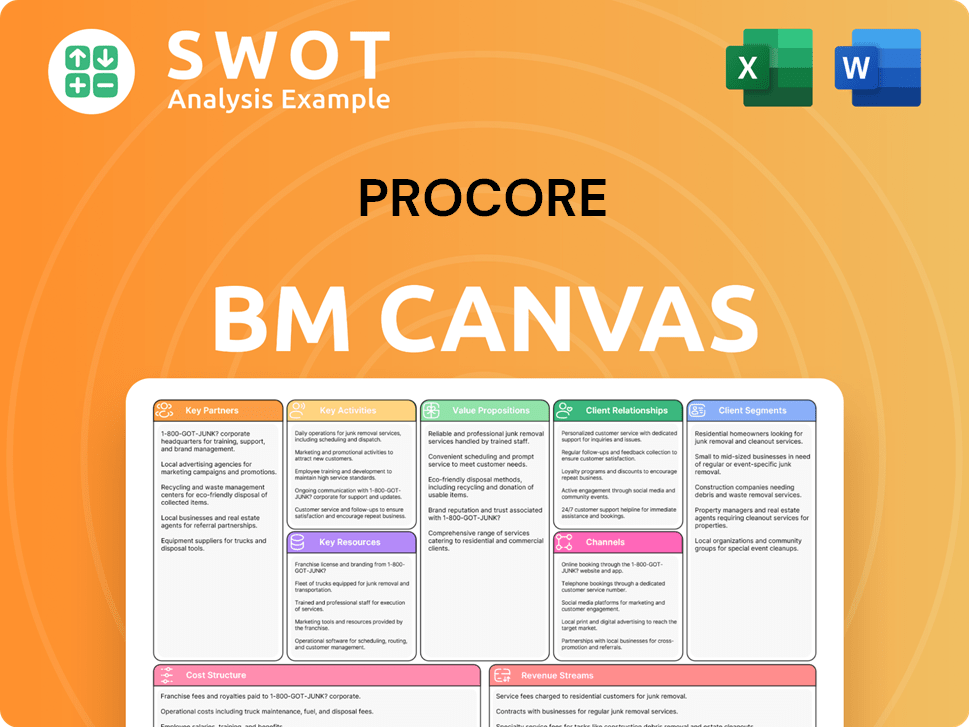
What Risks Could Slow Procore’s Growth?
Despite its promising outlook, the company, faces several potential risks and obstacles that could affect its Procore growth strategy and Procore future prospects. The competitive landscape, economic conditions, and internal execution challenges all pose significant hurdles. Understanding these risks is crucial for investors and stakeholders assessing the Procore company analysis and its long-term viability.
The construction industry's sensitivity to economic cycles means that any downturn could directly impact demand for its solutions. Furthermore, internal shifts in strategy and execution also present risks. The company's success hinges on its ability to navigate these challenges effectively while maintaining its competitive edge in the construction technology market.
Market competition is a significant risk for the company. Competitors sometimes outpace the company's revenue growth, raising questions about its competitive advantage in the construction management software market. The construction industry's cyclical nature, highly sensitive to macroeconomic conditions, also presents a challenge. Economic uncertainties, including inflation and interest rates, could negatively affect construction activity and, thus, the demand for the company's solutions. Tariffs on construction materials could lead to project delays or cancellations, impacting the company's growth prospects. The company's Procore market share is a key factor influenced by these market dynamics.
The construction technology market is highly competitive. Peers like Cadence (CADX) have sometimes shown stronger revenue growth. Staying ahead requires continuous innovation and a strong value proposition.
The construction industry is sensitive to economic cycles. Inflation, interest rates, and recessions can significantly affect construction activity. This can directly influence the demand for construction technology solutions.
The company is shifting to a general manager model, which could impact short-term growth. Management expects this new model to "grow at scale" in the second half of 2025. This transition may lead to missed opportunities or customer churn.
Labor shortages and supply chain issues in the construction industry can indirectly affect the company's customers. These challenges can impact project timelines and budgets, influencing the adoption and usage of its software.
Internal resources and execution risks are present, especially with strategic shifts. Effective management of these transitions is crucial to avoid setbacks and ensure continued growth. Strategic acquisitions are important as well.
The company aims to mitigate risks through technology innovation and strategic acquisitions. Maintaining a strong financial position is crucial to fund organic growth and potential share repurchases. The company is also focusing on Procore's target market.
The shift to a general manager model aims to enhance customer relationships and cross-sell opportunities. However, it may affect short-term growth. Management anticipates the new model to achieve scale in the second half of 2025, suggesting possible muted revenue growth in the first half of that year. This transition period requires careful management to avoid missed opportunities or customer churn.
The construction industry faces ongoing challenges such as labor shortages and supply chain disruptions. These factors can indirectly affect the company's customers and, by extension, its business. These issues can impact project timelines, budgets, and the overall demand for construction technology solutions. These challenges require proactive management to mitigate their effects.
Procore Porter's Five Forces Analysis
- Covers All 5 Competitive Forces in Detail
- Structured for Consultants, Students, and Founders
- 100% Editable in Microsoft Word & Excel
- Instant Digital Download – Use Immediately
- Compatible with Mac & PC – Fully Unlocked
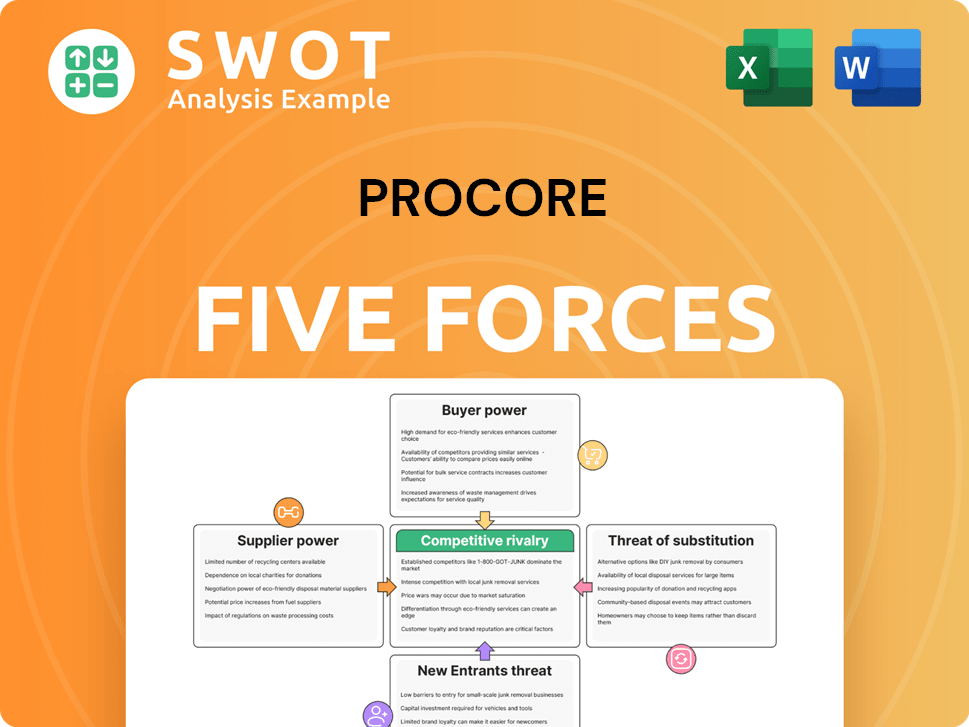
Related Blogs
- What are Mission Vision & Core Values of Procore Company?
- What is Competitive Landscape of Procore Company?
- How Does Procore Company Work?
- What is Sales and Marketing Strategy of Procore Company?
- What is Brief History of Procore Company?
- Who Owns Procore Company?
- What is Customer Demographics and Target Market of Procore Company?
Disclaimer
All information, articles, and product details provided on this website are for general informational and educational purposes only. We do not claim any ownership over, nor do we intend to infringe upon, any trademarks, copyrights, logos, brand names, or other intellectual property mentioned or depicted on this site. Such intellectual property remains the property of its respective owners, and any references here are made solely for identification or informational purposes, without implying any affiliation, endorsement, or partnership.
We make no representations or warranties, express or implied, regarding the accuracy, completeness, or suitability of any content or products presented. Nothing on this website should be construed as legal, tax, investment, financial, medical, or other professional advice. In addition, no part of this site—including articles or product references—constitutes a solicitation, recommendation, endorsement, advertisement, or offer to buy or sell any securities, franchises, or other financial instruments, particularly in jurisdictions where such activity would be unlawful.
All content is of a general nature and may not address the specific circumstances of any individual or entity. It is not a substitute for professional advice or services. Any actions you take based on the information provided here are strictly at your own risk. You accept full responsibility for any decisions or outcomes arising from your use of this website and agree to release us from any liability in connection with your use of, or reliance upon, the content or products found herein.